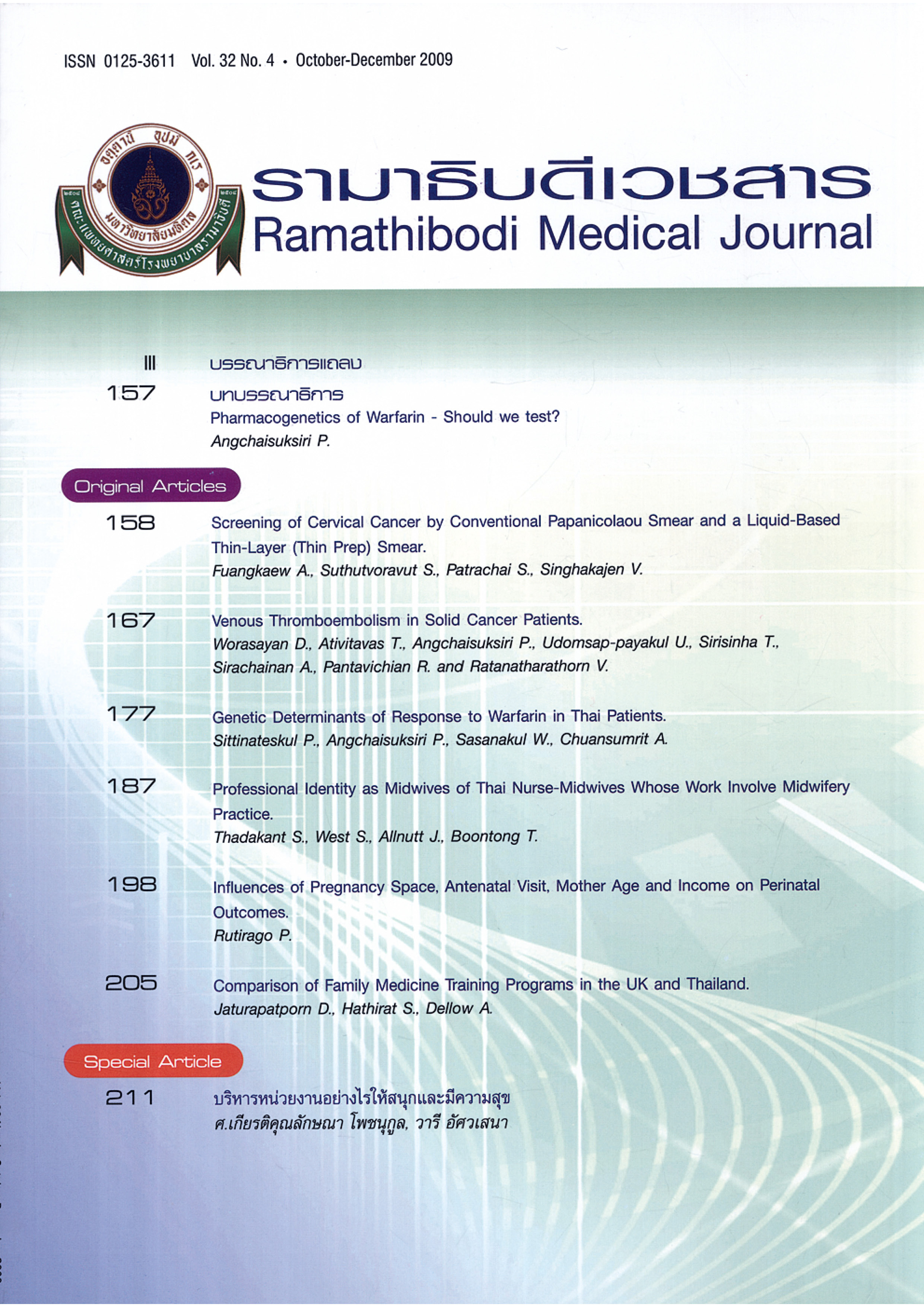Screening of Cervical Cancer by Conventional Papanicolaou Smear and a Liquid-Based Thin-Layer (Thin Prep) Smear
Keywords:
Screening, Cervical cancer, Conventional papanicolaou smear, Thin PrepAbstract
Objectives: To study the rate of cervical cancer screening in women and its results comparing between conventional Papanicolaou smear (Pap smear) method and Thin Prep smear method.
Material and Method: This is a descriptive study that analysis of the women who visited the gynecological out patient department (OPD) clinic of a private hospital in Bangkok, Thailand. The cervical cancer screening was done by conventional Papanicolaou smear (Pap smear) or Thin Prep smear. The rate of screening and results of abnormal findings were reported. Data was collected from gynecological OPD medical records during April to December, 2007.
Results: The results showed that among 5,943 women who came to a gynecological OPD clinic, 59.7%, (95% CI = 58.4, 60.9) were screened for cervical cancer, abnormalities were found in 31 women, 0.87%, (95%CI = 0.57, 1.18). The cervical cancer screening by Thin Prep found 5.8 times more abnormalities than by Pap smear (p < 0.05). Abnormalities were found by Thin Prep in 26 cases (1.56%) compared to 5 cases (0.27%) by Pap smear. Eighty percent of abnormal Pap smear results correlated with pathological diagnoses (4 out of 5 cases) compared to 77% (17 out of 22 cases) of Thin Prep. Significant factors associated with cervical cancer screening were age, occupation, marital status, number of living children and residence. Significant factors associated with the screening method were age, occupation, marital status and number of living children (p < 0.05).
Conclusion: The rate of cervical cancer screening in private hospitals was still less than expected. The Thin Prep smear method found more abnormal cervical cells than the Pap smear method but with comparable accuracy. This study could be useful in order to encourage a more appropriate screening method for women.
References
World Health Organization. State of the new vaccines: research and development, Initiative for Vaccine Research. Geneva: World Health Organization; 2003. Available at: http://www.who.int/vaccine_research/documents/en/stateofart_excler.pdf. Accessed November 21, 2003.
Program for Appropriate Technology in Health. Cervical cancer prevention. The reproductive health outlook. 2003. Summer Edition. Available at http://www.rho.org/assets/RHO_cxca_10-9-03.pdf. Accessed November 21, 2003.
Ferlay J, Bray F, Pisani P, et al. GLOBOCAN 2000: cancer incidence, mortality and prevalence worldwide, version 1.0. IARC Cancer Base No. 5. Lyon: IARC; 2001.
Parkin DM, Pisani P, Ferlay J. Estimates of the worldwide incidence of eighteen major cancers in 1985. Int J Cancer. 1993;54(4):594-606. doi:10.1002/ijc.2910540413.
Parkin DM, Muir CS, Whelan SL, Gao YT, Ferlay J, Powell J. Cancer Incidence in Five Continents. Volume VI. IARC Scientific Publication No 120, Lyon: International Agency for Research on Cancer; 1992.
Sankaranarayanan R, Budukh AM, Rajkumar R. Effective screening programmes for cervical cancer in low- and middle-income developing countries. Bull World Health Organ. 2001;79(10):954-962.
World Health Organization Media Centre. Cervical Cancer: Fact Sheet No. 297. February 2006. Available at: http://www.who.int/mediacentre/factsheets/fs297/en/.
Canavan TP, Doshi NR. Cervical cancer. Am Fam Physician. 2000;61(5):1369-1376.
Tomasulo J. Cervical Cancer Screening Thin Prep Technology. ACOG, American Cancer Society, Oklahoma: USA; 2008.
Committee on Infectious Diseases. Prevention of human papillomavirus infection: provisional recommendations for immunization of girls and women with Quadrivalent Human Papillomavirus Vaccine. Pediatrics. 2007;120(3):666-668. doi:10.1542/peds.2007-1735.
Davey E, d'Assuncao J, Irwig L, et al. Accuracy of reading liquid based cytology slides using the ThinPrep Imager compared with conventional cytology: prospective study. BMJ. 2007;335(7609):31. doi:10.1136/bmj.39219.645475.55.
Wang TY, Chen HS, Yang YC, Tsou MC. Comparison of fluid-based, thin-layer processing and conventional Papanicolaou methods for uterine cervical cytology. J Formos Med Assoc. 1999;98(7):500-505.
Minge L, Fleming M, VanGeem T, Bishop JW. AutoCyte Prep system vs. conventional cervical cytology. Comparison based on 2,156 cases. J Reprod Med. 2000;45(3):179-184.
Cheung AN, Szeto EF, Leung BS, Khoo US, Ng AW. Liquid-based cytology and conventional cervical smears: a comparison study in an Asian screening population. Cancer. 2003;99(6):331-335. doi:10.1002/cncr.11786.
Sriamporn S, Khuhaprema T, Parkin M. Cervical cancer screening in Thailand: an overview. J Med Screen. 2006;13 Suppl 1:S39-S43.
Duggan MA, Khalil M, Brasher PM, Nation JG. Comparative study of the ThinPrep Pap test and conventional cytology results in a Canadian cohort. Cytopathology. 2006;17(2):73-81. doi:10.1111/j.1365-2303.2006.00340.x.













